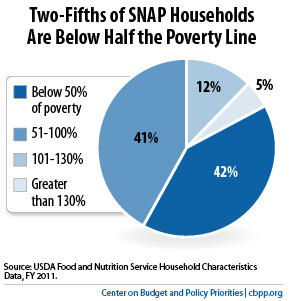BEYOND THE NUMBERS
With the House expected to vote in coming weeks on a proposal to “mindlessly gut” SNAP (formerly food stamps), as today’s New York Times editorial puts it, proponents are circulating misleading information about both the program and the proposed cuts. We will be issuing a series of posts, of which this is the first, that aims to set the record straight.

Close to two-thirds of recipients are children, elderly, or disabled. Most SNAP families that include at least one working-age, non-disabled adult are working households. (See our chartbook for more information.)
As our new paper explains, the emerging proposal from House Republican leaders would push at least 4 million people off SNAP by cutting the program by some $40 billion over ten years — almost nine times the cut in the farm bill that the Senate passed in June.
The proposal includes the $20.5 billion in SNAP cuts in the farm bill that the House rejected in June, plus new provisions designed to cut at least another $20 billion in benefits.
The low-income people who face the loss of food assistance include many:
- poor, unemployed, childless adult individuals who live in areas of high unemployment — whose average income is only 22 percent of the poverty line, or about $2,500 a year— even if they want to work but can’t find a job or an opening in a training program;
- other poor, unemployed parents who want to work but can’t find a job or job training; and
- people who have gross incomes or assets modestly above the federal SNAP limits but disposable income (the income that a family actually has available to spend on food and other needs) below the poverty line in most cases, often because of high rent or child care costs. Most of these people are working families or seniors.
Next up: correcting misinformation about poor childless adults and SNAP.
